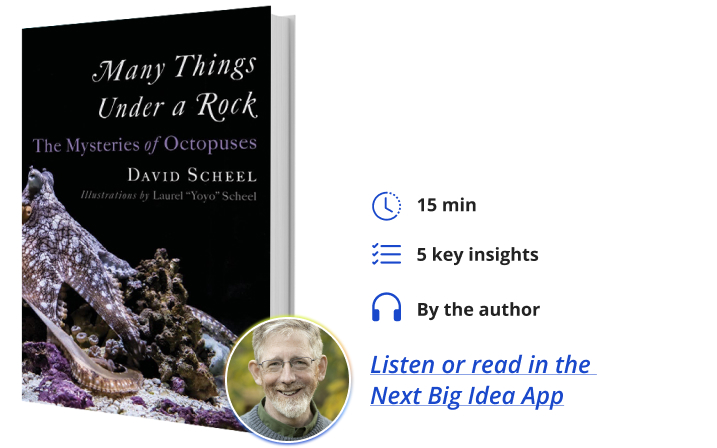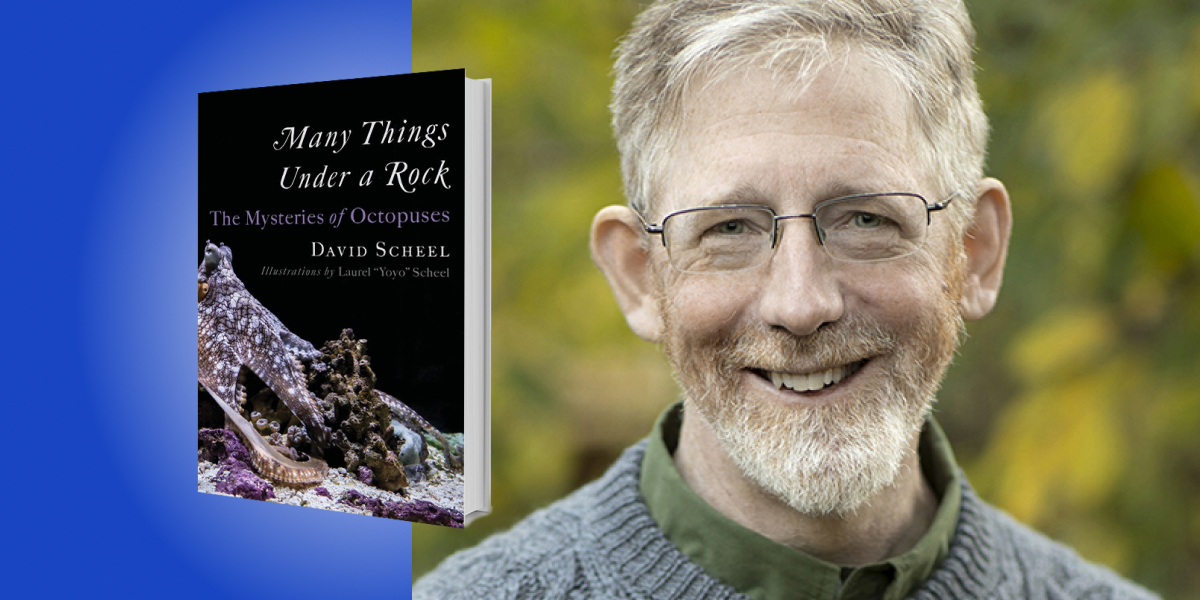David Scheel is a professor of marine biology at Alaska Pacific University and has researched the behavior and ecology of octopuses for over 25 years. He holds a Ph.D. in ecology from the University of Minnesota. Below, he shares five key insights from his new book, Many Things Under a Rock: The Mysteries of Octopuses. Listen to the audio version—read by David himself—in the Next Big Idea App.

1. Octopuses are like us, with a twist.
All animals share universal needs: food, safety, and the need to find suitable mates. To decide which of our many needs to pursue in any given instant, animals must weigh those felt internal needs against opportunities and risks in the environment. Octopuses are no exception to this pattern; and octopuses thus experience primordial emotions, such as hunger, fear, pain, and the drive to mate. By learning about octopuses, therefore, we learn more about ourselves.
In one study, octopuses were given the recreational drug ecstasy. In humans, this rave drug increases empathy and the desire to be physically close to others and to touch them. But we’re social animals. What would the drug do in an octopus? It turns out the effects are the same, because much of the underlying physiology of drug-binding sites and neural cells share deep roots, despite an ancient divergence from our last common ancestor with octopuses. Octopuses given ecstasy try to stay closer to other octopuses, and are more likely to reach out and touch them. Just like us.
Despite our vastly different anatomy and lifestyles, deep down, we and octopuses are fellow animals with more in common than we have differences that divide us. Deep evolutionary commonalities underlie all of biological diversity.
2. Globally, octopuses are doing okay—but that’s probably a temporary state.
The harvesting of the oceans has likely benefited octopuses by removing large fish and mammals that prey on them, and also by depleting their competitors that use similar prey or dens. But continued harvesting also depletes their food and depletes the octopuses themselves. Climate change will alter their ranges and may ultimately reduce their abundance. In the cold North Pacific, warming waters have already resulted in fewer octopuses.
Over the last few decades, the shapes of two curves, of octopus abundance and of North Pacific temperatures, look like mirror images, though there is a time lag. After temperatures spiked up, octopus counts were low a year or two later. The lag corresponded to the approximate age of the octopuses. After accounting for the lag, when our oceans warm, octopus counts fall. This is for the colder-water giant Pacific octopus, not just in Alaska but also for Puget Sound in Washington.
“In the cold North Pacific, warming waters have already resulted in fewer octopuses.”
In other areas of the world, such as the seas around southern England, ocean warming may lead to the common octopus expanding its range northward. So some octopus species may have larger ranges as the planet warms up, while others are already experiencing declines or shrinking areas of suitable habitat.
Everywhere, however, there is less to eat than there once was, as clams and crabs are harvested by people. Less food means octopuses grow more slowly. Smaller octopuses are more vulnerable to predators or produce fewer eggs.
3. Octopuses are smart, but intelligence is not what you think it is.
Smart behaviors are built from curiosity, persistence, and flexibility.
I once found the entrance to an octopus den at the base of a boulder, and the remains of a meal the octopus had left at the door. The octopus was on top of the boulder with one arm wrapped neatly around a kelp stipe. Alert and watching, she waited to see if I would look up and notice her. She was curious. When I did notice her, she pushed into the emerald green water, jetting away.
I followed, swimming fast and intent not to lose sight of her. She broke to the right. My gaze followed, but she cast a sepia cloud of ink into the water. Jetting beyond it, she turned sharply left. Undeterred, I pursued through the ink cloud and saw her dart into a patch of kelp. She froze. She turned translucent burnt sienna, the color of the brown kelps. Her skin roughened and became the texture of the kelp. My eye could only find her among the fronds if I focused on her suckers, on her eyes.
Flexibility: first watching, then flight, inking, and dodging. Now camouflage. She clung to the brown kelp, camouflaged. Keeping my eyes on hers, I reached blindly for a collecting bag that I had clipped to my dive belt. I fumbled for it. Reached again. Fumbled again. For a brief second, I glanced down to find the bag; and to put my hand where it needed to be. I glanced back up into empty kelp, ink hanging in the water. She was gone.
Persistence: still working to outsmart me, even after several changes in tactics. And I had lost her.
4. Relationships are important.
Octopuses in captivity recognize their caretakers, and wild octopuses also recognize other octopuses and fish. They also recognize their predators and their prey species as different types of actors—different from other moving objects like wafting kelp or debris drifting by.
Judging these relationships (and how to navigate them) is important to octopuses, just as relationships are important to you. Consider just the species that an octopus will hunt. Within this category, octopuses sometimes tackle Alaska false jingles, a type of oyster anchored to the rock. They also attempt to capture butter clams (buried), decorator crabs (camouflaged and still), helmet crabs (fleet-footed), shrimp (abrupt escape movements), scallops (erratic swimmers), fish (directed and swift swimmers), Sally Lightfoot crabs (fleet-footed prey that escapes above the water line onto rocks) and sometimes even birds. Octopuses must assume the correct attitude to capture their prey: some by pushing their arms into crevices and under rocks, some by pouncing with the web spread, and others with a lightning-fast grab of the arms. There is judgment in these methods, of how the prey will relate to the octopus attack, and the octopus chooses the appropriate technique for each different target.
“Octopuses in captivity recognize their caretakers, and wild octopuses also recognize other octopuses and fish.”
This nuance is extended further, to escaping from different predators, dealing with rivals, and even to the den mates that sometimes share space with an octopus. In Jervis Bay, Australia, I saw a gloomy octopus comfortably ensconced in her den next to three fish—Southern Bastard Codlings. The three codlings, smooth red fish with orange lips and chin barbells, pressed against each other, each facing out of the den alongside the octopus. There was hardly more space between the octopus and the nearest fish than between the fish themselves—they were touching at times. The four looked very much at home together, like long-familiar roomies.
The octopus actively maintained her den space, excavating the cavity and defending the space against other intruders. What did the codlings bring to this gathering? Possibly nothing. Perhaps the fish do not bother the octopus or are too dogged to evict. Having them there may cost the octopus nothing. This may be the case, although the close contact suggests the octopus could quite easily make a meal of the closest of these. Might the octopus just like the company?
5. There are many “best” ways to do something.
The value of diversity is that there are lots of paths to success, lots of ways to understand the world. Without clear cause, a resting scallop startles and jets itself up, clapping the beat of its own propulsion, then falls back to rest again at the bottom. A nearby gloomy octopus turns his head with interest at the motion. He stretches from his den toward the resting scallop and extends two front arms in a pincer move to either side of the prey. One curls around the shell. The octopus tucks his lunch under the web, and makes a small jet back toward home, but at this point drops the scallop again.
Why catch the scallop, his staple food, but not eat it? It was as though the visual system of the octopus recognized the scallop as a meal, so it picked up the scallop and took it back to the den to eat. Once out of sight under the web, the touch-taste system of the suckers found the scallop unpleasant or uninteresting—and the octopus let it go. How could this be? Did the gloomy octopus know what its arms and suckers were doing?
“The value of diversity is that there are lots of paths to success.”
Many scallops have a shell encrusted with sponges that cover at least one side. To an octopus, scallops look like food, and their swimming behavior draws the eye. When given both sponge-encrusted and bare-shelled scallops, however, octopuses are two to five times as likely to feed on the bare-shelled prey.
The indecisive gloomy octopus, seeing a swimming scallop, captures it for a meal. Once captured, the prey left the visual system and passed under the web, to the touch-taste system. This scallop was heavily covered with sponge, which octopuses don’t eat. The well-adapted suckers, therefore, released the scallop, which was then free once again to be seen swimming past the octopus, who can recognize an easy meal when he sees one!
Despite such circumstances that demonstrate conflicting input from the two systems, the octopus needs both. Vision detects predators and tracks fleeing prey. Touch-taste identifies valuable food or dangerous risks when the arms are out of sight, hard at work exploring crevices. These very different systems work well together, doing more than either could alone, despite occasional conflicts, which don’t seem to upset the octopus at all.
To listen to the audio version read by author David Scheel, download the Next Big Idea App today:































